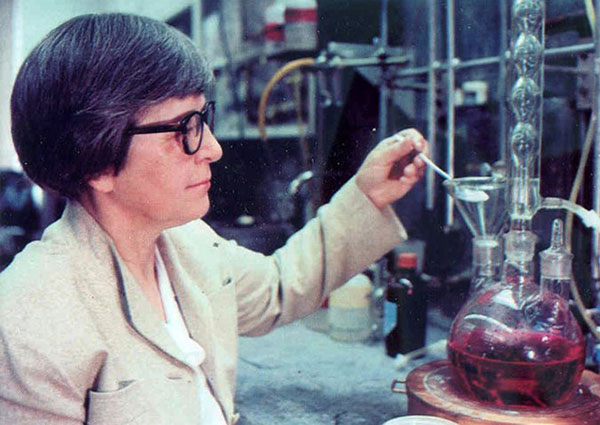Stephanie L. Kwolek - The inventor of Kevlar died at age 90
Stephanie L. Kwolek, a chemist who invented Kevlar, a lightweight and ultra-durable material used to produce bulletproof armor, has just died at the age of 90. This invention is the result of 15 years of hardship. Sharpen silent research at DuPont Chemical Company, where Kwolek worked to help save millions of lives around the world. Kwolek has been dubbed the "bulletproof master" and recognized by the world's scientists as a pioneering model of women doing science.
Stephanie Louise Kwolek was born on July 31, 1923 in New Kensington, USA in a Polish family. From a young age, Kwolek always dreamed of becoming a doctor but the family did not have enough money to help her attend medical school. In 1946, she graduated from Carnegie Mellon University, Pittsburgh. Immediately after graduation, Kwolek started working at a laboratory under the DuPont Chemical Company in Wilmington. During the study here, Kwolek had an invention that made her name famous all over the world: Kevlar .

Chemist Stephanie Louise Kwolek
Kevlar is the commercial name of the aramid hard, well-known and well-known aramid fiber with a synthetic resin reinforcement application in bulletproof vests or household tools. According to DuPont chemical company estimates, since the 1970s, bulletproof armor has helped save more than 3,000 police officers across the United States. Until now, Kevlar fiber has continued to be developed to improve the durability and weight significantly reduced compared to the original prototype.
In addition to being used as bulletproof vests, Kevlar is also present all over the world with many different applications. Kevlar can be used in tires, boots for firefighters, hockey sticks, knife catchers, optical cables, fire-proof mattresses, armored vehicles and used as materials for canoe production. In addition, Kevlar is also used as a construction material for buildings that are bulletproof, bomb resistant. People also use Kevlar to build safe rooms in the house to quickly rain, storms, . Even, Kevlar is also used to enhance the load capacity for road and bridge projects.
The study led to the birth of Kevlar that began in the 1960s. This is the period when the appearance of women in the scientific world is quite rare. And then, female chemist Kwolek led the research team at the lab of DuPont Chemical Company with the goal of developing a durable material, enough to replace the steel used in radial tires.

In 1964, Kwolek conducted tests to convert polymer materials from solid to liquid. However, the result is not the same as the original expectations. It is only a dilute solution that is opaque. Therefore, Kwolek's colleagues did not approve of her research direction. However, she continued to experiment. Her solution is to "turn" the polymer solution with a silk-making machine in the laboratory to remove all solvent liquids.
And very casually when Kwolek put the polumer solution into the silk machine, she found that polyamide molecules (a liquid crystal) contained in the solution lined up in parallel with each other. When the cooled solution will form extremely hard fibers. Kwolek was amazed at the finding. After that, she continued to conduct tests based on the type of fiber formed.
Through a series of tests conducted in 1965, Kwolek found that this is a durable fiber like steel with equal weight and especially fire resistant. Just then, Herbert Blades, Joseph Rivers and many leaders at DuPont soon realized the immense commercial potential of this particular yarn. And finally, tires that use "B fiber" (first name of Kevlar) were tested in Richmond factory.

Kevlar is used in military helmets
Nearly a decade later, researchers began developing short-sleeve bulletproof vests using Kevlar fibers. In 1975, the first bulletproof armor was officially equipped at many police departments in the United States. The later versions continue to be reinforced and reinforced with Kevlar class numbers to increase safety for the wearer. Since 1990, armor has been added with ceramic plates to increase fire resistance.
And since then, protective clothing has been continuously developed and refined based on the original Kevlar yarn invented by Kwolek. In addition, Kevlar fiber is also used to manufacture a wide range of products in many different industries around the world. Finally, the author of this groundbreaking material has died, but perhaps her name will live forever as an example of women doing science with her great contributions to human development. species.
- The inventor of the laser died
- Death story because of the
- You will be surprised with the special equipment of the 11-year-old inventor
- 10 inventors died because of
- Great inventor is alien to most people
- World's most powerful inventor with 3,500 patents
- The computer mouse father died at the age of 88
- Artificial muscles from synthetic fibers
- The number of inventors will decrease because of the Internet
- The father of the remote television controller died
- 29 years old, 29 patents
- US Army tests armor armor with dragon armor with better bullet resistance than Kevlar
 The most famous scientific failures in history
The most famous scientific failures in history Mysterious genius mechanic and the machine froze time
Mysterious genius mechanic and the machine froze time The son carries the 'bad gene' of genius Albert Einstein
The son carries the 'bad gene' of genius Albert Einstein Isaac Newton
Isaac Newton